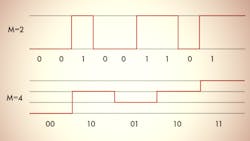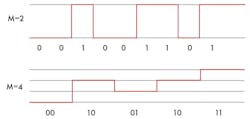This is part of the Communication Series: What’s the Difference: Serial Communications 101
Download this article in .PDF format
PAM-4, which could be a catalyst for reaching 400-Gb/s Ethernet, will also likely find homes in high-speed serial interfaces such as FibreChannel. Pulse amplitude modulation (PAM) is a way to pack more bits into the same amount of time on a serial channel.
The usual mechanism used in serial communications is the binary non-return to zero (NRZ). NRZ tracks the values being sent; therefore, an idle state, where all the bits are the same value, leaves the signal at the same level during the idle time (Fig. 1). NRZ differs from return to zero (RZ), which transitions to the 0 level for each bit. RZ is self-clocking, but it requires more bandwidth.
An alternative to NRZ is NRZ Inverted (NRZI), in which a 1 bit is indicated by a transition from one level to another. An idle using a 1 value will result in the signal cycling each bit.
NRZ and NRZI aren’t inherently self-clocking, but there are ways to address this issue. One is to use bit stuffing, which forces a transition after a set number of bits. Another approach is to only allow particular patterns that will have sufficient transitions to maintain an accurate clock at the receiver. Manchester encoding is one example of the latter. Ethernet, for instance, employs an 8B/10B Manchester code that encodes 8 bits of data using 10-bit codes. The 10-bit codes are chosen to give the data characteristics necessary for clock recovery from the data.
Encoding more data into the same timeframe can be done using different signaling levels. Such multi-level signaling (MLS) or pulse amplitude modulation (PAM) can have multiple distinct levels. Actually, NRZ is a two-level MLS or PAM-2 system. PAM-4 (Fig. 2) has four distinct levels to encode two bits of data, essentially doubling the bandwidth of a connection.
Of course, there’s no such thing as a free lunch. Generating or decoding more than two levels is typically more difficult, and often requires better or more complex hardware. Likewise, for high-speed signals, random and induced noise becomes a significant factor. The approach begins to pay off when there’s an escalation in cabling costs. That’s the hope anyway when it comes to 400 Gigabit Ethernet, which will likely employ eight PAM-4 connections running at 28 GHz.
Read more in this Communication Series: What’s the Difference: Serial Communications 101
About the Author
William G. Wong
Senior Content Director - Electronic Design and Microwaves & RF
I am Editor of Electronic Design focusing on embedded, software, and systems. As Senior Content Director, I also manage Microwaves & RF and I work with a great team of editors to provide engineers, programmers, developers and technical managers with interesting and useful articles and videos on a regular basis. Check out our free newsletters to see the latest content.
You can send press releases for new products for possible coverage on the website. I am also interested in receiving contributed articles for publishing on our website. Use our template and send to me along with a signed release form.
Check out my blog, AltEmbedded on Electronic Design, as well as his latest articles on this site that are listed below.
You can visit my social media via these links:
- AltEmbedded on Electronic Design
- Bill Wong on Facebook
- @AltEmbedded on Twitter
- Bill Wong on LinkedIn
I earned a Bachelor of Electrical Engineering at the Georgia Institute of Technology and a Masters in Computer Science from Rutgers University. I still do a bit of programming using everything from C and C++ to Rust and Ada/SPARK. I do a bit of PHP programming for Drupal websites. I have posted a few Drupal modules.
I still get a hand on software and electronic hardware. Some of this can be found on our Kit Close-Up video series. You can also see me on many of our TechXchange Talk videos. I am interested in a range of projects from robotics to artificial intelligence.



